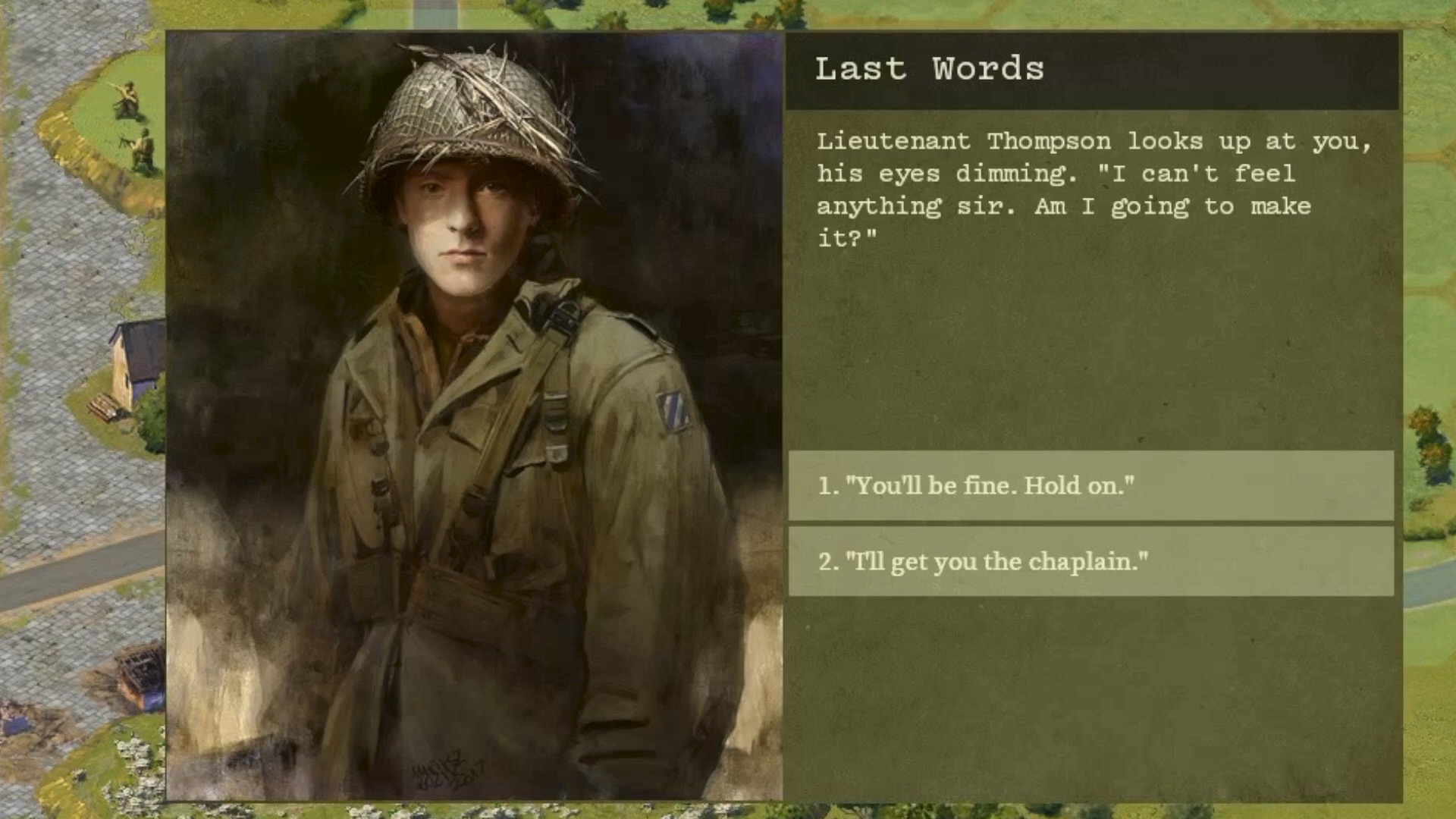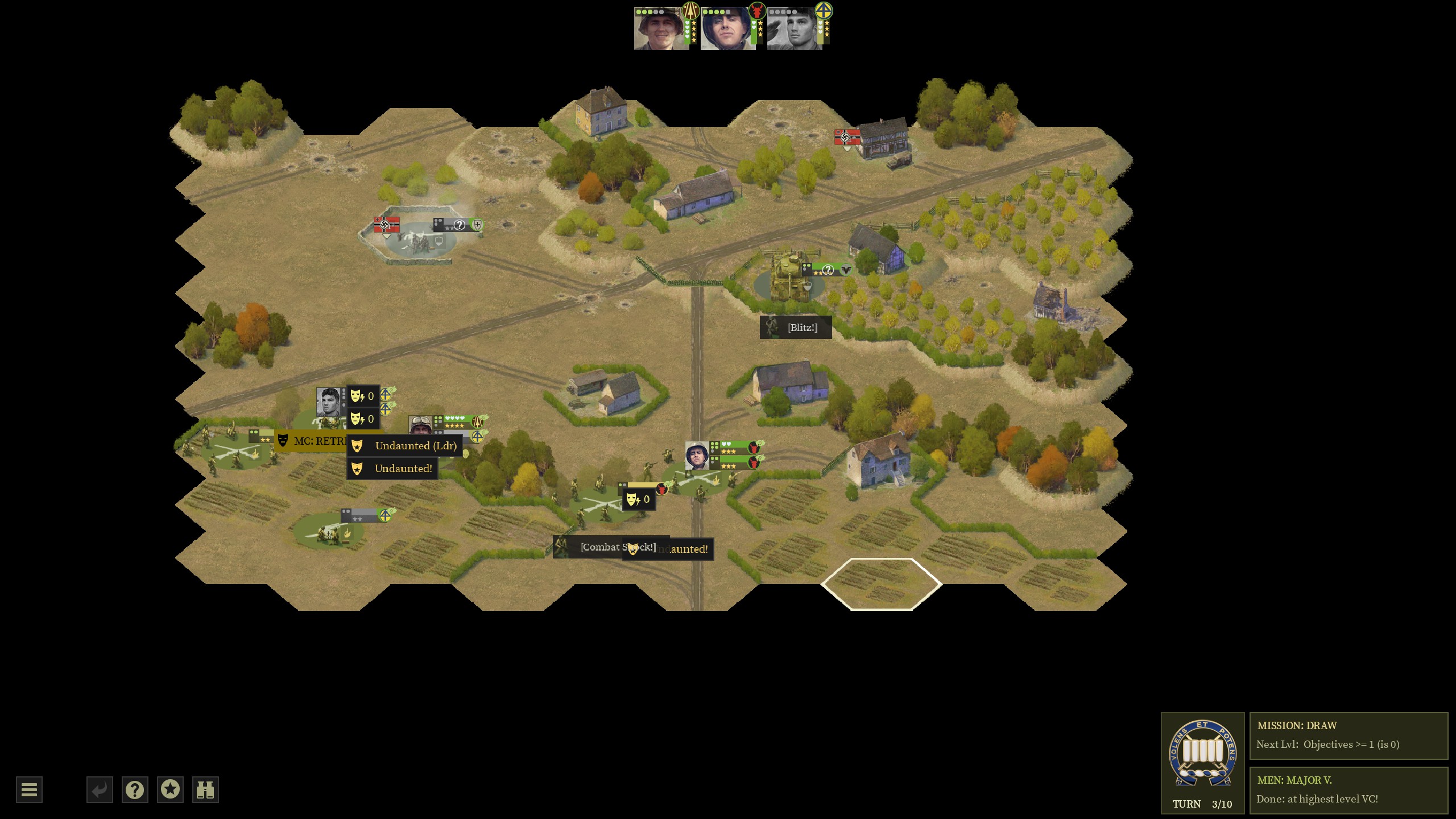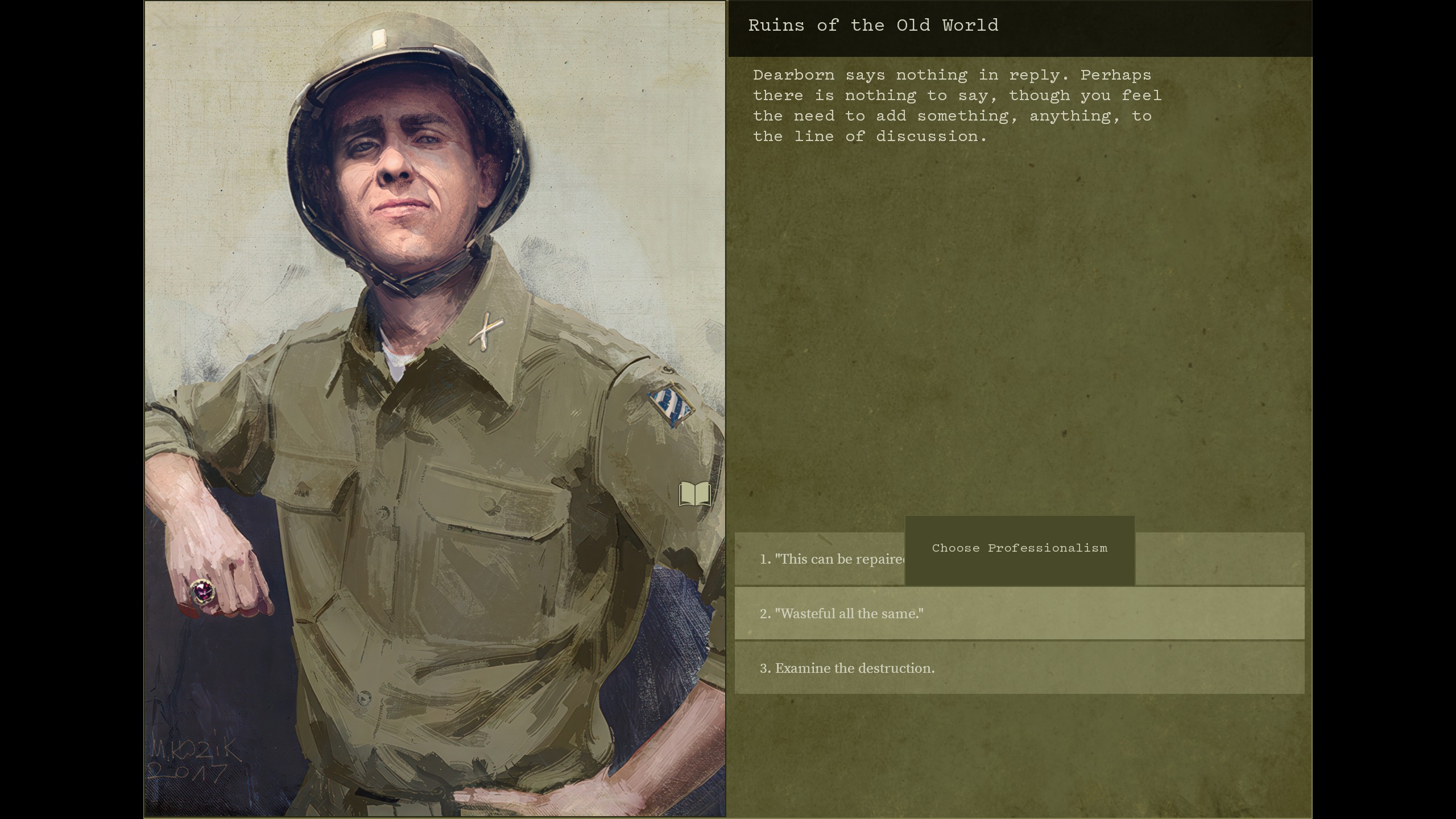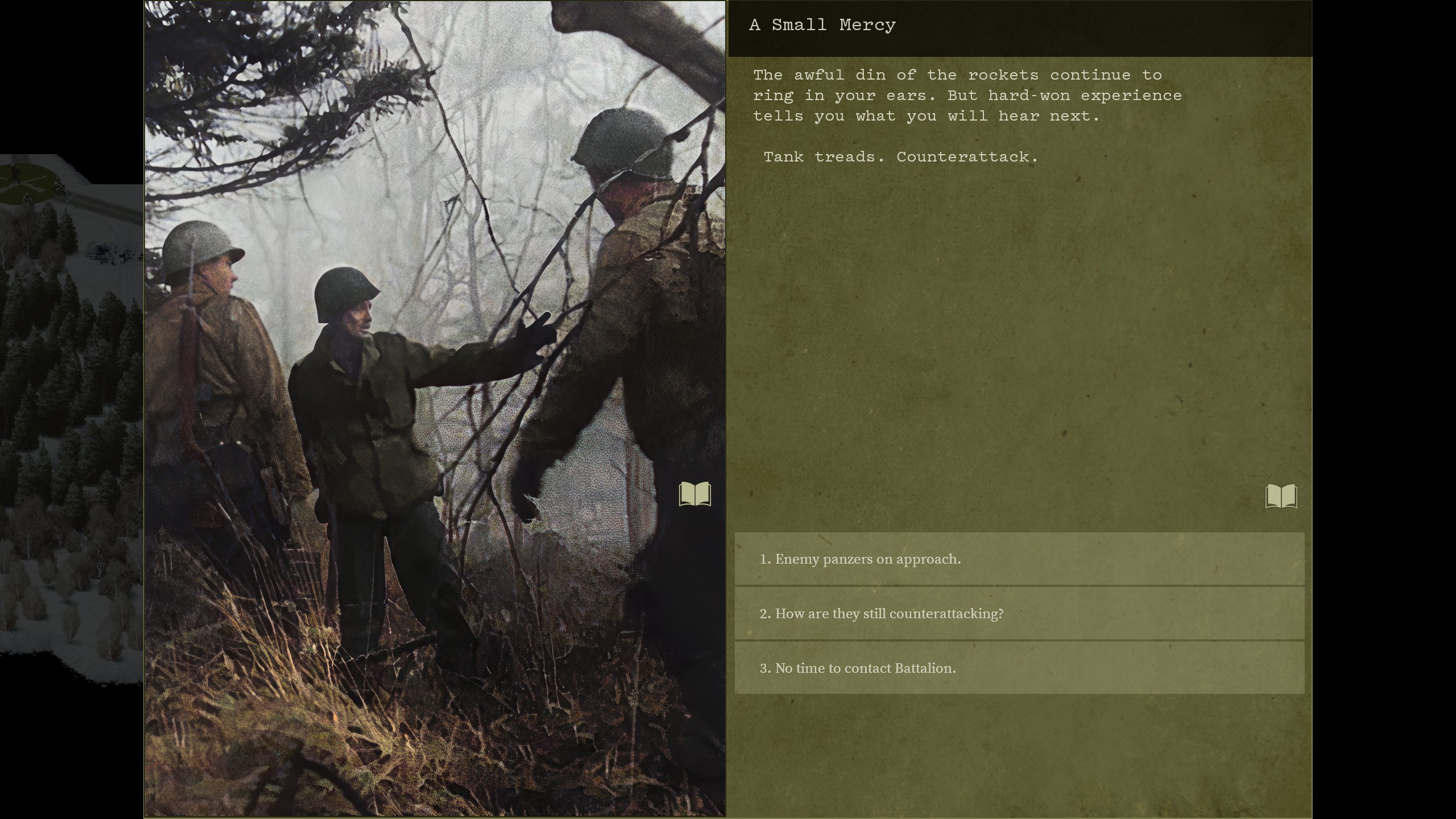
There's no shortage of World War 2 biographies and movies about the brutal reality and shocking bravery of leadership in combat. For whatever reason, though, I've never experienced a campaign wargame that sought to capture not just the tactical but the interpersonal life of soldiers and officers who fought alongside each other for years at a time. That's the goal of Burden of Command, an upcoming game which bills itself as a "World War 2 tactical leadership RPG" but uses game rules that will be pretty familiar to a lot of players of classic hex-and-counter wargames.
I got access to a few training missions and two short scenarios in a pre-release build of Burden of Command, and found an interesting hybrid of wargame relationship-management RPG. Burden of Command starts before the characters go to war, in training missions where your soldiers aren't even using live ammunition—they're carrying around metal pipes and wooden logs to sub in for their heavy weapons like machine guns and mortars.

The story isn't just about the battles, but about the people in them.
This is very much on purpose. Burden of Command clearly aspires to a kind of true-to-life realism inspired by shows like Band of Brothers and drawn from the stories told by veterans. It's a kind of realism that leans on using subtly-altered photography and in-spirit events from the time period. To that end your training missions are mimed as real-world training exercises using the characters who'll go to war together. They're complete with referees carrying clipboards and blowing whistles to pause the exercise every so often while they roll dice or discuss how to adjudicate something.
The story isn't just about the battles, but about the people in them. You name and customize a single character—a lieutenant—as your point-of-view officer and choose how they interact with others and develop their career. You're consistently given dialogue choices mid-stream of combat: Whether to give a snarky response to a senior officer, for example, is a bit of flavor that bumps up your level of Sarcasm or Seriousness, influencing which dialogue choices you can make further down the line. Conversely, telling the fresh-out-of-the academy rookie officer that his clever tactic is a bad plan would present a choice between the officer trusting you more for letting him try it or your soldiers trusting you more for defending their safety against a fellow officer.
There are three social resources to manage. Prestige, which endears you to your superiors and gets your troops priority replacements and requisitions. Trust, which measures how much your fellow officers will work with you. And Loyalty, which is the degree to which the rank-and-file soldiers will follow you into battle without asking questions. This is Advanced Squad Leader or Close Combat by way of Fire Emblem.

Taking your shot
Turns go in alternating phases with the enemy, who play by the same rules as you. Each phase you pick one of your company's leaders—the lieutenants—and move them and their squads. That means you'll only ever move about a third of your units each phase until every unit on both sides has acted. Each squad is something like a team of riflemen or a weapon crew on a machine gun or mortar. Every unit has action points. Moving the officer themself around costs one of their actions, but so does activating any one of the units under their control, which can then spend the rest of its one or two action points for no further cost to the officer.
Avoiding casualties is one of your foremost concerns.
But officers only have four or so action points that are also shared with their key functions: Rallying troops who're under fire and bolstering those who have to lead assaults against the enemy. That means an officer will rarely be able to utilize all three squads in their platoon each round.
The movements of your soldiers and officers are never trivial. An officer in the wrong place who isn't properly leading near the front can't rally their soldiers when they come under unexpected fire. One who's too exposed and comes under fire themself can lose action points to suppressive fire or even be killed, crippling that section of the company as the next officer in line has to take charge.

Accordingly, this wargame combat system gives you the priorities of real field leaders. Avoiding casualties is one of your foremost concerns, and every scenario has both the tactical objectives command has given you and the soldiers' own objective to keep as many people alive as they can. Morale is therefore more important than anything else. You have to fire on enemies multiple times to pin them and not be fired upon yourself in turn—or, if you are under fire, make sure you're in good cover and have officers handy to rally the troops for counter-fire.
Removing enemy units from the map, as in the historical conflict that the US forces you're playing fought, is mostly about using gunfire and artillery to pin the enemy in place followed by a close-range assault that forces the enemy to retreat or surrender. Both exchanges of gunfire between squads and those assault actions are risky, with even seemingly sure shots having a chance of failure. Brave soldiers are very impressive, but even if the enemy is under a withering barrage those veterans might balk at charging what they know is a machine gun position.
The scenarios I played were very time-focused, with limits on how quickly you needed to accomplish them in order to get a degree of victory or defeat—minor, major, etc. That meant balancing careful advances with bold moves, seizing as much ground as I could without being spotted. Positioning is key, as is taking enemies by surprise, because the scenarios all included optional objectives that popped up as you went on.

No plan survives
In one scenario, my sergeants reported that wrecked tanks from an attack the day before still had friendly soldiers wounded and cowering in them. I had to decide whether to riskily send troops into the open to save those tankers. Having saved them, I now had units out of position and under extra fire when unexpected enemy reinforcements arrived. That meant I had no choice but to retreat later, even though I'd taken the main objective of a crossroads and house… but my soldiers loved our officers more for the bravery we had shown and command was impressed by that effort.
Overall, Burden of Command didn't remind me of many other digital wargames. There are high-level strategy games that include interactions between army officers, but this was more like tactical RPGs such as Fire Emblem or Valkyria Chronicles, except grounded in Band of Brothers-style realism. Meanwhile, the command structure and wargame rules aren't that common in videogames, which tend to focus on the fantasy of complete power, so the gameplay has more in common with tabletop wargames rules like Chain of Command or Crossfire.

Like many wargames it was at times a bit clunky. It wasn't always clear which units should or can act, or how an objective was considered completed, but those kinds of user experience quirks can be ironed out during and after development. It's part and parcel with the genre. The big question I'm left with is whether this kind of multi-branching mission structure will mesh well with the long-term management of your soldiers to form a well-balanced campaign. That, and if the decisions your officers make and the stories they undergo will be compelling over what will surely be dozens of hours of combat in North Africa, Italy, and Europe—not to mention a bit of running around with sticks in the Virginia woods.
For now, I'm very intrigued by what I saw, and I think that wargame enthusiasts will be well served by paying attention to Burden of Command as it approaches release early next year.







